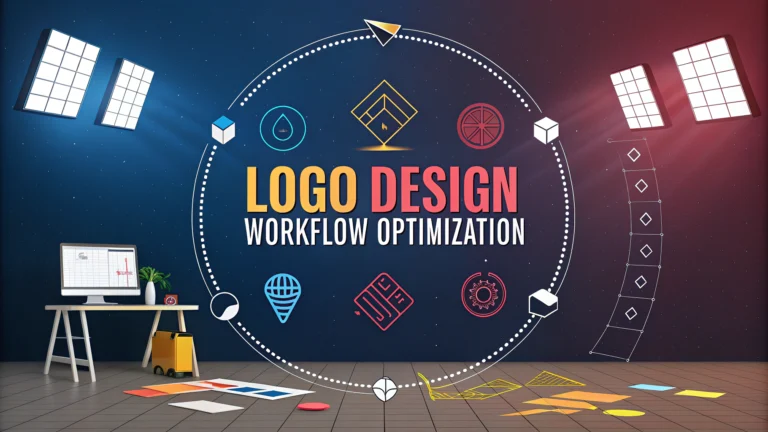A well-planned logo design workflow helps designers create better work faster while keeping clients happy throughout the process.
Project Planning & Setup
Start every project with a detailed creative brief that outlines the client’s goals, target audience, brand values, and technical requirements.
- Set clear project milestones and deadlines
- Define deliverable formats (AI, EPS, PNG, etc.)
- Establish number of concepts and revision rounds
- Document brand guidelines if they exist
Research Phase
Research sets the foundation for an effective logo design that resonates with the target audience.
- Analyze competitor logos and branding
- Study industry design trends
- Create mood boards for visual direction
- Document color psychology research
Sketching & Concept Development
Always start with quick pencil sketches to explore multiple directions rapidly before moving to digital.
- Aim for 20-30 rough sketches minimum
- Focus on basic shapes and forms
- Test different typography options
- Select 3-5 strongest concepts to develop
Digital Development
Use vector software like Adobe Illustrator to create clean, scalable logo designs.
- Build using basic shapes
- Test in black and white first
- Create custom typography when needed
- Use proper naming conventions for files
Testing & Refinement
Test logos thoroughly before presenting to clients.
- Check scaling at different sizes
- Test reverse versions on dark backgrounds
- Review in grayscale
- Mock up on relevant applications
Recommended Tools
| Purpose | Tool |
|---|---|
| Vector Design | Adobe Illustrator, Affinity Designer |
| Sketching | Adobe Fresco, Procreate |
| File Management | Dropbox, Google Drive |
| Project Management | Trello, Asana |
File Organization Tips
- Create separate folders for sketches, working files, and final deliverables
- Use version numbers (v1, v2) for different iterations
- Keep original artwork files separate from exported versions
- Back up all files regularly
Client Presentation
Present logo concepts professionally with real-world mockups and clear explanations of the design rationale.
- Show logos in context
- Explain color choices
- Demonstrate versatility
- Include technical specifications
For more guidance on logo design tools and techniques, contact professional design organizations like AIGA (www.aiga.org) or the Graphic Artists Guild.
Design Best Practices
Following established design principles ensures logos remain effective and timeless across all applications.
- Keep designs simple and memorable
- Ensure readability at all sizes
- Create balanced compositions
- Consider negative space opportunities
Common Mistakes to Avoid
Understanding potential pitfalls helps designers create more professional logo designs.
- Using too many colors or effects
- Following trendy designs that may date quickly
- Creating overly complex illustrations
- Relying too heavily on stock elements
Delivery & Handoff
Proper file preparation and organization ensures clients can effectively use their new logo.
- Prepare all requested file formats
- Include usage guidelines document
- Provide color codes and typography details
- Archive master files securely
Conclusion
A systematic logo design workflow combines creative exploration with technical precision and client collaboration. Following these established processes helps designers create meaningful, lasting brand identities while maintaining efficiency and professionalism throughout the project.
Remember to regularly update your workflow as new tools and techniques emerge in the design industry. Stay connected with the design community and continue learning to refine your process over time.
FAQs
- What are the essential steps in a professional logo design workflow?
A professional logo design workflow includes client briefing, research, sketching concepts, digitizing selected concepts, refining designs, presenting to clients, implementing feedback, and preparing final deliverable files. - Which software tools are most effective for logo design?
Adobe Illustrator is the industry standard for logo design, followed by Affinity Designer, Figma, and CorelDRAW. Vector-based software is essential as logos must be scalable without losing quality. - How long should the logo design process typically take?
A professional logo design process typically takes 2-4 weeks, including client communication, concept development, revisions, and finalizing deliverables. - What file formats should be included in final logo deliverables?
Final logo deliverables should include AI, EPS, SVG, PDF vector files, and raster formats like PNG and JPEG in various sizes. Color variations should include CMYK, RGB, and monochrome versions. - How can I streamline the client feedback process in logo design?
Use collaborative design platforms, create structured feedback forms, present designs professionally with mockups, limit revision rounds in contracts, and establish clear feedback deadlines. - What research should be conducted before starting the logo design process?
Research should include competitor analysis, target audience demographics, industry trends, color psychology, client’s brand values, and historical context of similar successful logos. - How many initial concepts should be presented to a client?
Present 3-5 strong, distinct concepts to avoid overwhelming the client while providing enough variety for meaningful choice and discussion. - What are the most common bottlenecks in logo design workflow?
Common bottlenecks include unclear project briefs, delayed client feedback, excessive revision requests, poor file organization, and inadequate initial research. - How should logo files be organized for optimal workflow?
Maintain a clear folder structure with separate directories for working files, client presentations, approved designs, and final deliverables. Use consistent naming conventions and version control. - What elements should be included in a logo design brief?
A comprehensive brief should include company background, target audience, competitors, preferred styles, color preferences, intended logo applications, timeline, and budget constraints.








